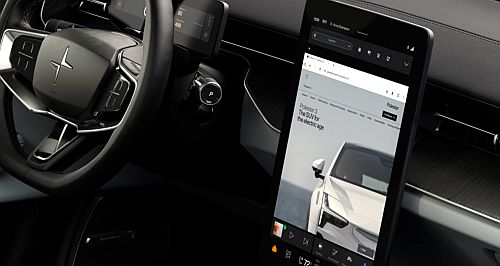News - PolestarCES: Twinning tech a winning strategyDigital twinning allows earlier design collaborations, faster in-car technology roll-out11 Jan 2024 By MATT BROGAN COLLABORATIONS between car manufacturers and technology giants may be nothing new.
But the process of so-called ‘technology twinning’ is becoming an increasingly important piece of the vehicle design process, with more systems integrated more deeply into the vehicle design than at any time in the past. It is an imperative element of bringing the latest technology to market in the shortest possible timeframe.
Demonstrating this vital relationship at the 2024 Consumer Electronics Show (CES) in Las Vegas this week were two such collaborations – the first between Polestar and Google, and the second between Stellantis and Blackberry.
Polestar continues its strategic relationship with Google at CES this year, the latest innovations for cars with Google (Android) built-in now introduced in Polestar vehicles including the Polestar 2 and Polestar 3.
Among the capabilities offered by the Android-based technology is the ability to send a planned route from your mobile device directly to the car. The system is ready to roll-out immediately and allows users to plan trips on Google Maps on their Android or iOS device and simply send the planned route to their Polestar’s infotainment system.
Polestar – an early adopter of in-car internet browsing – launched its Vivaldi browser technology in the Polestar 2 back in 2021. Now, Chrome browser is starting to roll-out for Polestar 2 models (in beta), bringing drivers a “familiar and easy-to-use browsing experience while parked”.
“Google is one of the more important technology partners,” said Polestar CEO Thomas Ingenlath.
“Since launching the Polestar 2 over three years ago, we have seen the Android Auto OS ecosystem expand with a long list of new apps and functionalities being introduced.
“Our strong relationship continues to deliver new features for Polestar owners, and they will enrich Polestar 3 and Polestar 4 this year as well.”
Similarly, Stellantis and Blackberry announced that they are collaborating on a “virtual cockpit” style of technology the pair says will allow much faster delivery of infotainment technology and cut development costs.
The digital interface recreates car controls and systems in the cloud, and will accelerate development times in some instances to less than 24 hours, instead of the usual several months.
As part of Stellantis’ Virtual Engineering Workbench development tool, the system combines Blackberry’s QNX Hypervisor software with Amazon Web Services to provide the very latest in cloud-based services.
“Essentially, we are able to get closer to our customers’ needs through this technology with faster development cycles, faster feedback loops, and quicker delivery of the technology they know and love,” said Stellantis chief software officer Yves Bonnefont.
Stellantis said it expects to generate as much as $US22 billion ($A32.8b) in revenue from software and connected car services by the end of the decade as part of its Dare Forward 2030 plan. The group is developing three software-based technology platforms – STLA Brain, STLA AutoDrive, and STLA SmartCockpit.
Stellantis said its STLA SmartCockpit technology is expected to be operational in millions of vehicles from this year.  Read more10th of January 2024  Volkswagen tech key to longer EV battery lifeVW-backed EV battery tech set to offer 485,000km service life, faster charging, better range9th of January 2024  CES: Bosch, Hyundai detail hydrogen plansMobility giants announce future plans for hydrogen engine technologies in Las Vegas15th of December 2023  Morgan, Fellten EV collaboration is goAll-electric ‘Super 3’ edges closer as Morgan and Fellten join forces on XP-1 prototype |
Click to sharePolestar articlesMotor industry news |
















Facebook Twitter Instagram